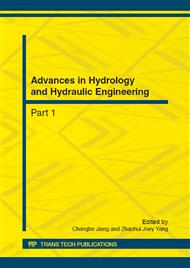p.1057
p.1062
p.1067
p.1071
p.1076
p.1083
p.1092
p.1098
p.1103
Study on Short-Term Scheduling of Day-Controlled Hydropower Station Base on the Minimum Range of Stage
Abstract:
Base on the peak-load adjustment of the upper station and the consideration of downstream flow for shipping requirement, a minimum range of stage model, which is suitable for the day-controlled hydropower station, has been proposed in this paper. Taking certain hydropower station as an example, the minimum range of stage model has been studied in this paper with the dynamic programming method. And the results show that, although there would be a little losing of electric generated energy, the range of stage will be minimum fluctuation and the electric output process smooth through all the time, which means that the minimum range of stage model is suitable for the requirements of day-controlled hydropower station.
Info:
Periodical:
Pages:
1076-1080
Citation:
Online since:
October 2012
Authors:
Price:
Сopyright:
© 2012 Trans Tech Publications Ltd. All Rights Reserved
Share:
Citation:


